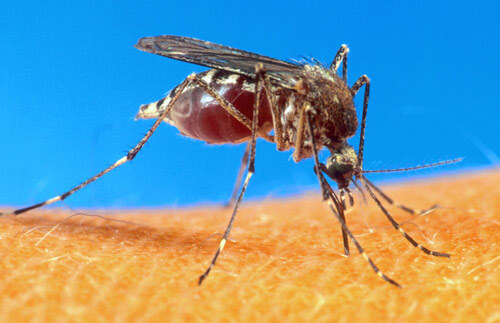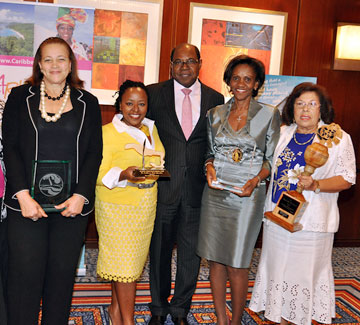The executive director of the Trinidad-based Caribbean Public Health Agency (CARPHA), Dr. James Hospedales, is urging the Caribbean to heed strong advice to stem the further spread of the Chikungunya virus, as the Stockholm, Sweden-based European Center for Disease Prevention and Control (ECDC) reported last week more than 100,000 suspected cases of the virus in the region.
“For Caribbean people, we have to step up our efforts,” Trinidadian-born Hospedales told Caribbean Life in an exclusive interview on Sunday. “We urge people to seriously examine their environment and discard anything that would encourage the mosquitos to breed.”
He said that the Chikungunya virus — a painful, mosquito-borne infection — has been spreading rapidly in the Caribbean since late last year, stating that dozens of cases have been reported across the region.
“Chikungunya is a new virus to the region. It came in December last year; and, as of last week, we have reports from 18 jurisdictions, including all the language areas – English-speaking, French, Dutch and Spanish islands,” Hospedales said.
He said, since the virus has not been in the Caribbean before, people are susceptible.
“There is no resistance, and we have a lot of the mosquitoes that transmit it,” he said, pointing to the Aedes aegypti mosquito that transmits dengue fever, for example.
“Chikungunya is a wake-up call so we can get more mosquito control,” added Hospedeles, stating that it has the same potential as dengue.
He said CARPA has been advising travelers to the Caribbean to prevent Chikungunya infection by avoiding mosquito bites.
“Therefore, when travelling to countries with ongoing outbreaks of Chikungunya fever, CARPHA would like to advise that you take proper precautions to prevent being bitten,” he said.
CARPHA also wants travelers to use insect repellants containing DEET, Picaridin, oil of lemon eucalyptus, or IR3535 on exposed skin.
Travelers should also wear long-sleeved shirts and long pants; use air conditioning, or have windows/doors securely closed or screened when indoors; and sleep under mosquito nets, the Caribbean health agency urged.
Hospedales also said that players in the tourism industry need to be very concerned about the disease.
He disclosed that CARPHA has been working with Caribbean Tourism Organization (CTO) officials on some of the communications messages.
“One of the things is that it’s not only the population that might fall ill, but actually your workers in the workforce, and that’s what’s happening now,” Hospedales said.
The ECDC said on Jun. 6 that, as of June 4, there were also at least 14 fatalities from the virus in the region. Of the suspected cases, 4 182 were confirmed in the Caribbean region and 224 in South America, the ECDC.
As of June 4, the ECDC said there were 33 confirmed cases in Anguilla; four cases in Antigua and Barbuda; one 1 imported case in Aruba, originating from Sint Maarten; 1, 817 suspected cases and 122 confirmed cases in Dominica; 38 639 suspected, 17 confirmed cases and one death in the Dominican Republic; 23, 100 suspected and 1, 328 confirmed or probable cases, and one death in Guadeloupe; and six confirmed cases and 6,312 suspected cases in Haiti.
In addition, the ECDC said there were 29,200 suspected and 1, 515 confirmed or probable cases, and nine deaths in Martinique; one confirmed case in Puerto Rico; 520 suspected and 135 confirmed or probable cases in St. Barthélemy; 22 confirmed cases in St. Kitts and Nevis; five confirmed cases in St. Lucia; 3, 320 suspected and 793 confirmed or probable cases, and three deaths in French St. Martin (French); 110 suspected cases and 57 confirmed cases in St. Vincent and the Grenadines; 325 suspected and 301 confirmed cases in Dutch Sint Maarten; and 20 confirmed cases in the British Virgin Islands.
The ECDC also said there were 222 confirmed or probable cases, 74 percent of which were autochthonous, in French Guiana; and two confirmed cases in Guyana.
In addition to confirmed autochthonous cases, the ECDC said several countries have reported imported cases of chikungunya in patients with travel history to the affected areas: the U.S. (Florida), Barbados, Trinidad, Chile, Panama, France and Italy.
“The latest epidemiological data indicate increasing number of cases in most affected countries and that the outbreak is still expanding and reaching new areas,” the ECDC said.
It said the chikungunya transmission was detected “during a concomitant dengue outbreak in the Caribbean.”
The ECDC said both arboviruses are transmitted by the same Aedes aegypti mosquito species.
“The naïve population, the presence of an effective vector in the region and the movement of people in and between islands and territories are factors that make it likely that the outbreak will continue to spread geographically and continue to increase in numbers,” it said.
On Dec. 6, 2013, France reported two laboratory-confirmed autochthonous cases of chikungunya in the French part of the Caribbean island of St. Martin.
It was the first time that autochthonous transmission of the virus has been documented in the Americas.
An ECDC risk assessment of the outbreak, published on Dec. 12, 2013 concluded that the risk of the disease spreading to other islands in the Caribbean region was “high.”
“The conclusions and recommendations of the rapid risk assessment published on 12 Dec. 2013 remain valid,” the ECDC said.
“Clinicians and travel medicine clinics should remain vigilant regarding imported dengue and chikungunya cases from the Caribbean, French Guiana and Guyana,” it warned.

























